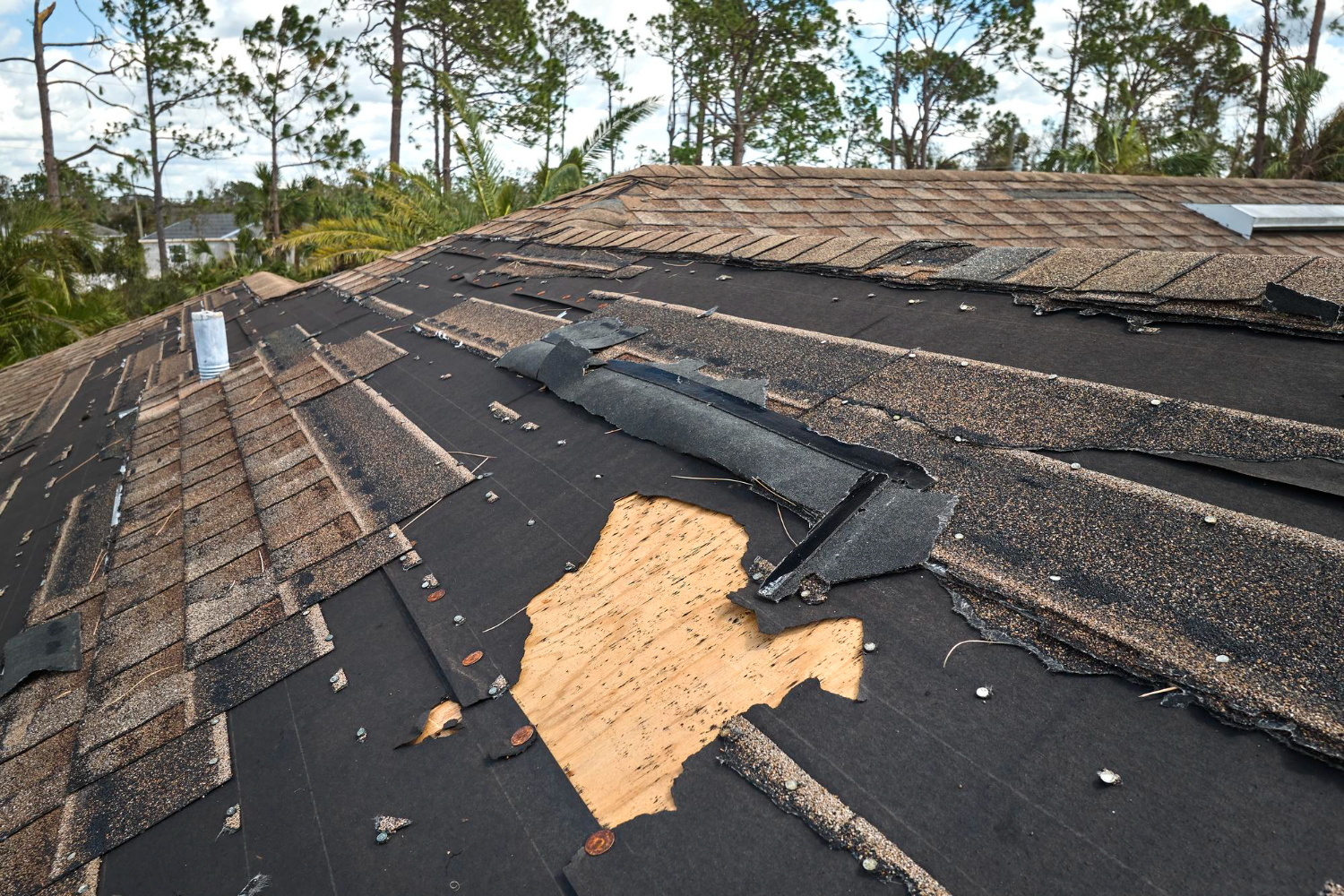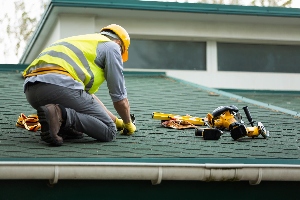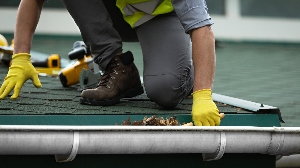Your roof shingles face a constant battle against the elements every day. Weather conditions like extreme heat, UV exposure, rain, snow, hail, and high winds gradually weaken shingles over time, causing them to crack, warp, become brittle, and eventually fail. Understanding how different weather patterns affect your roof helps homeowners take the right steps to protect their investment.
The damage happens slowly at first, but it adds up over years of exposure. Hot sun can make asphalt shingles dry out and crack. Heavy rain and snow can lead to leaks when shingles are already weakened.
Recognizing the warning signs of weather damage and knowing how to maintain your roof throughout the year can save thousands of dollars in repair costs.
In this article, you’ll learn how weather affects roof shingles and the practical steps to prevent damage and extend roof life year-round.
Here’s what you need to know:
- The connection between weather and roof durability
- Common weather conditions that damage roof shingles
- Signs your shingles are weather-damaged
- How to protect and maintain your roof year-round
Keep reading! Learning about the connection between weather and roof durability gives homeowners the knowledge they need to keep their homes protected.
The connection between weather and roof durability
Weather patterns directly damage roof shingles through temperature changes, sun exposure, and seasonal cycles. These forces cause materials to break down faster than normal aging.
How temperature swings cause shingles to expand and crack
Shingles expand when temperatures rise and contract when they drop. This constant movement puts stress on the material day after day.
Daily temperature changes create the most damage. A roof can heat up 30-40 degrees higher than air temperature during sunny days. At night, it cools back down quickly.
This cycle happens every single day. Over months and years, the stress builds up in the shingle material.
Cracks start small but grow larger over time. They usually begin at the edges of shingles where movement is greatest. Once cracks form, water can get underneath and cause more problems.
Different shingle types handle temperature changes differently:
- Asphalt shingles become brittle in cold weather
- Composite shingles may warp in extreme heat
- Wood shingles split along the grain when they dry out
Winter freeze-thaw cycles are especially hard on roofs. Water gets into small cracks, freezes, and expands. This makes the cracks bigger each time it happens.
The impact of UV rays on asphalt and composite shingles
According to ENERGY STAR, cool roof products can lower roof surface temperatures by up to 50°F, helping curb heat-driven shingle deterioration and slowing UV-related aging
Sun damage happens slowly but never stops. UV rays break down the chemical bonds in shingle materials.
Asphalt shingles lose their protective granules first. These small rock pieces reflect sunlight and protect the asphalt underneath. When granules fall off, the asphalt is exposed to direct sun.
Exposed asphalt becomes dry and brittle. It starts to crack and curl at the edges. The shingles may also fade from their original color.
Composite shingles face similar problems. The resins and fibers that hold them together weaken under constant UV exposure. This leads to shingle deterioration that affects the whole roof system.
Heat buildup makes UV damage worse. Dark-colored shingles absorb more heat than light ones. This extra heat speeds up the breakdown process.
Signs of UV damage include:
- Curling or cupping shingle edges
- Granule loss in gutters
- Faded or discolored areas
- Brittle shingles that crack easily
South-facing roof sections usually show damage first. They get the most direct sunlight throughout the day.
Why seasonal changes speed up roof wear and tear
Each season brings different challenges that wear down shingles faster than steady weather would.
Spring rains test shingles that may have cracked during winter. Heavy storms can lift loose shingles or drive water under damaged ones. Wind-driven rain is especially hard on older roofs.
Summer heat dries out shingle materials. This makes them less flexible and more likely to crack. Extreme heat can also cause shingles to warp or buckle.
According to the U.S. Environmental Protection Agency (EPA), cool roofs with high solar reflectance and thermal emittance lower temperatures on the roof and inside the building, helping mitigate heat-driven shingle aging and related wear.
Fall weather brings temperature swings and storms. Falling leaves can clog gutters and trap moisture against shingles. This creates conditions for rot and mold growth.
Winter conditions are often the hardest on roofs. Snow loads add weight. Ice dams can form when snow melts and refreezes at the roof edge.
The constant change from season to season never gives shingles time to stabilize. Materials that might last longer in steady conditions break down faster when they face different stresses all year long.
Shingle deterioration speeds up most in areas with extreme seasonal differences. Roofs in these climates need more frequent inspections and maintenance.
Common weather conditions that damage roof shingles
Weather events create specific types of roof damage that homeowners can identify and address. Hail breaks down shingle surfaces, strong winds lift and tear materials, and winter conditions cause structural stress through ice formation and temperature changes.
How hailstorms cause granule loss and surface dents
Hailstones act like hammers when they hit roof shingles. The impact knocks off the protective granules that shield shingles from UV rays and weather.
Size matters for damage severity:
- Pea-sized hail: Minor granule loss
- Quarter-sized hail: Noticeable surface dents
- Golf ball-sized hail: Deep dents and exposed mat
The granules protect the asphalt layer underneath. When hail removes these granules, the shingle becomes vulnerable to sun damage and cracking.
Fresh hail damage looks like dark spots where the black asphalt shows through. These spots appear random across the roof surface.
Older shingles suffer more damage than newer ones. The asphalt becomes brittle over time, making it easier for hail to create holes or tears.
Wind damage and how to spot lifted or missing shingles
Strong winds create uplift pressure under shingle edges. This force can lift, crack, or completely remove shingles from the roof deck.
Common wind damage signs include:
- Curled or bent shingle edges
- Missing shingles with exposed underlayment
- Loose or hanging shingles
- Granules in gutters after storms
Winds above 45 mph can damage healthy shingles. Older or poorly installed shingles fail at lower wind speeds.
The roof edges and corners face the most wind stress. These areas often show damage first during storms.
Missing shingles leave the roof deck exposed to rain and moisture. This exposure can cause wood rot and interior water damage quickly.
The hidden dangers of snow, ice dams, and freeze-thaw cycles
Snow and ice create multiple problems for roof shingles. The weight puts stress on the roof structure while ice formation damages materials.
Ice dams form when:
- Snow melts on warm roof sections
- Water refreezes at cold roof edges
- Ice blocks normal drainage
According to the U.S. Department of Energy, ice dams form when heat from the house warms the roof, causing meltwater that refreezes at the eaves and can force water under shingles; improving air sealing and attic insulation is a primary prevention strategy.
The trapped water behind ice dams seeps under shingles. This water can leak into the home and cause ceiling damage.
Freeze-thaw cycles expand and contract roofing materials. This movement creates cracks in shingles and loosens nails over time.
Temperature changes cause:
- Shingle cracking from expansion stress
- Nail loosening from repeated movement
- Flashing separation at joints
Heavy snow loads can cause shingles to shift or break. The extra weight also stresses gutters and roof supports.
Signs your shingles are weather-damaged
Weather damage to shingles often shows specific warning signs that homeowners can spot with careful observation. Missing granules, interior water damage, and structural changes signal that storm damage roof repair may be needed soon.
Discoloration, curling, and granule buildup in gutters
Granule loss is one of the first signs of weather damage. Hail, heavy rain, and strong winds knock the protective granules off shingle surfaces. These granules collect in gutters and downspouts.
Check your gutters after storms. Large amounts of granules mean your shingles are losing their protective coating. This makes them weak against future weather.
Curling shingles happen when edges lift up or curl. This occurs after repeated heating and cooling cycles. Wind and rain get under curled edges and cause more damage.
Discoloration shows up as dark spots or streaks on shingles. Weather exposure breaks down the materials. Some discoloration is normal aging, but sudden changes after storms signal damage.
Look for cracked or split shingles too. Temperature changes make shingles expand and contract. This creates cracks that let water seep through.
Leaks or water stains inside your home after storms
Water stains on ceilings or walls are clear signs of roof damage. These stains often appear days or weeks after storms. The water travels along roof structures before showing up inside.
Check your attic first after severe weather. Look for wet spots, water drips, or damp insulation. Damaged shingles let water penetrate the roof deck.
Brown or yellow stains on interior walls mean water has been leaking for some time. Fresh leaks may not stain right away. They often start as small wet spots.
Sagging ceiling areas indicate serious water damage. This happens when water collects above ceiling materials. This type of damage needs immediate attention.
Missing or loose shingles create entry points for water. Even small gaps can cause major interior damage over time.
When minor weather damage turns into a major roof issue
Small problems grow fast without proper attention. A few missing granules can lead to complete shingle failure. Cracked shingles let water reach the roof deck underneath.
Water damage spreads quickly once it starts. Wet roof decking can rot and weaken the entire roof structure. Mold and mildew also grow in damp areas.
Multiple damaged shingles often mean widespread problems. If several shingles show weather damage, the whole roof may need inspection. Storm damage roof repair costs increase when problems spread.
Structural issues develop when water reaches roof supports. Rotted wood beams and damaged insulation are expensive to replace. These repairs cost much more than fixing surface damage early.
Professional inspection helps catch problems before they worsen. Roofing contractors can spot damage that homeowners might miss.
How to protect and maintain your roof year-round
Regular inspections after storms and choosing the right materials can prevent small damage from becoming expensive problems. Professional repairs also save money by fixing issues before they require full roof replacement.
Scheduling regular roof inspections after extreme weather
Homeowners should check their roof within 24-48 hours after severe storms, high winds, or hail events. These weather conditions often cause damage that isn't visible from the ground.
Key areas to inspect include:
- Missing or cracked shingles
- Damaged flashing around chimneys and vents
- Clogged or damaged gutters
- Loose or bent metal trim
Property owners should look for granules in gutters after hailstorms. This indicates shingle damage that weakens the roof's protection.
Professional inspections work best for steep roofs or after major storms. Roofers can spot problems that untrained eyes might miss.
Document any damage with photos for insurance claims. Take pictures from multiple angles to show the full extent of problems.
Using impact-resistant shingles for long-term protection
Impact-resistant shingles reduce damage from hail, falling branches, and flying debris during storms. These shingles earn UL 2218 ratings from Class 1 to Class 4, with Class 4 offering the highest protection.
Benefits of impact-resistant shingles:
- Lower insurance premiums in many areas
- Longer lifespan than standard shingles
- Better wind resistance up to 130 mph
- Reduced cracking from temperature changes
Class 4 shingles can withstand 2-inch hail strikes without damage. Standard shingles often crack or lose granules from much smaller hail.
The higher upfront cost pays off through fewer repairs and insurance discounts. Many manufacturers offer longer warranties on impact-resistant products.
These shingles work especially well in areas with frequent severe weather like Texas, Colorado, and the Midwest.
Why professional repairs prevent costly replacements later
Small roof problems grow into major issues when left untreated. A few loose shingles can let water damage the roof deck, insulation, and interior walls.
Professional roofers fix problems correctly the first time using proper materials and techniques. DIY repairs often fail within months, leading to more damage.
Common problems that need professional attention:
- Flashing repairs around penetrations
- Structural damage to roof decking
- Multiple missing shingles
- Chimney or vent boot replacement
Water damage spreads quickly once it starts. What begins as a $200 repair can become a $15,000 replacement if ignored for months.
Licensed contractors provide warranties on their work. This protection gives homeowners peace of mind that repairs will last.
Professional repairs also maintain manufacturer warranties on roofing materials. DIY work often voids these important protections.
Conclusion
Weather poses constant challenges to roof shingles throughout the year. From harsh UV rays to freezing temperatures, each weather condition creates specific types of damage that homeowners must address.
Understanding weather impacts helps protect your investment. Different materials respond differently to weather conditions. Some shingles handle heat better, while others resist wind damage more effectively.
Regular maintenance becomes essential for shingle longevity. Property owners should inspect their roofs after major weather events. Early detection prevents small problems from becoming expensive repairs.
The right materials make a significant difference in weather resistance. Impact-resistant shingles perform better in hail-prone areas. Metal and slate options offer superior durability against extreme weather conditions.
Weather damage accumulates over time rather than happening all at once. Homeowners who understand these gradual effects can take preventive action. This knowledge helps maintain roof performance and prevents costly emergency repairs.
Professional assessment provides the most accurate evaluation of weather-related damage. Qualified contractors can identify problems that untrained eyes might miss.
Schedule a professional roof inspection with Michaelis today to assess weather damage, prioritize repairs, and protect your home before the next storm.




.avif)

